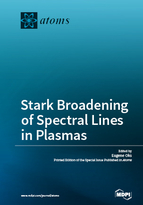Laboratory Hydrogen-Beta Emission Spectroscopy for Analysis of Astrophysical White Dwarf Spectra
Round 1
Reviewer 1 Report
This is an ambitious review
that covers a particular aspect within the very wide scope subject of
hydrogen-beta line shape. The review provides some practical and useful
information for the readers. The authors have managed to cite a large
number of relevant papers. I still find a few references that should be
cited in connection with the line-shape asymmetries that are mentioned
in the manuscript. In particular, the authors should mention the need to
consider quadrupole and high-order effects for high density regime. The
references are:
1. “Correlation effects and their influence on line broadening in
plasmas”, by Stambulchik et al. 2007. (this reference is relevant to the
ion-ion correlations, see Refs 24-25).
2. "Effect of higher-order multipole moments on the Stark line shape", by Gomez et al. 2016.
3. The most recent review, “Beyond the linear Stark Effect…”, by Demura.
Other, rather minor comments:
1. Line 63: the name “extreme ultraviolet explorer” should be first-letter capitalized.
2. Line 67: The author should check the quoted value for the
hydrogen interstellar density. If it is rather for the column density,
then the units should be in cm-2 (not cm-3).
3. Line 111: the statement that Debye shielding is a broadening
phenomenon can be misleading. It has an effect, but it is not a broadening
mechanism by itself. I suggest to rephrase the sentence.
4. Line 254: It is not clear if Ref. 66 that is mentioned in the
previous paragraph is related to the statement that the
accuracy of the H_a density diagnostics is 20-30%. Such a statement
requires a justification or reference that should clearly appear.
Author Response
Response to Reviewer 1
The comments and corrections are greatly appreciated. Modifications in revision 1 are indicated in red for reviewer 1: added the suggested references (see text line 38, line 119, and three References starting line 367). All minor corrections are included: correction#1 (line66), correction#2 (line70), correction#3 (line 114), and correction #4 (line 261).
Reviewer 2 Report
I recommend publication of this article.
Regarding line shape models for magnetic white dwarfs: in complement to [58] the authors may consider the following reference
N. Kieu et al., Atoms 2017, 5, 44; doi:10.3390/atoms5040044
At the end of Sec. 2.1 and at some other locations in the text, it is mentioned that the hydrogen beta line profile shows Lorentz line shape asymptotic behavior in the wings. This is true under the assumption that the line profile is a convolution with Lorentzian function, but this assumption is not valid in general (the so-called issue of incomplete collisions, not addressed in impact broadening models, occurs precisely at large frequency detuning). I suggest the authors mitigate their statement in order to avoid confusion.
On equation (3): the units of \delta w_{H_{\beta}} are missing.
Appendix C, Eq. (A7): the functions \Phi, \chi, \Lambda, \Delta are not defined. If \Phi denotes the total line shape, then I guess a convolution sign “*” should be used instead of “+”.
Ref. [73] title: typo “High-precision…”
Author Response
Response to Reviewer 2
The comments and corrections are greatly appreciated. Modifications in Revision 1 are indicated in green for reviewer 2: Added the suggested Reference (line 472); Mitigated the comment on Lorentz broadening in the wings (line 116); Added units in Equation (3) (line 98); Included corrections regarding the functions in Eq. (A7) (line 317 and line 319); Corrected the typo in References (line 513).




